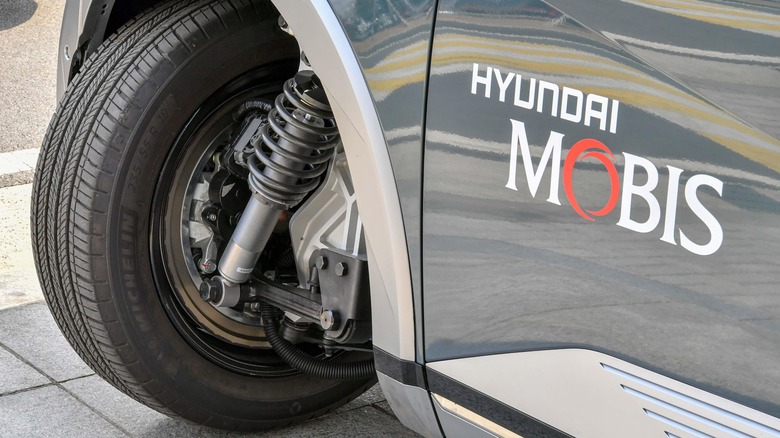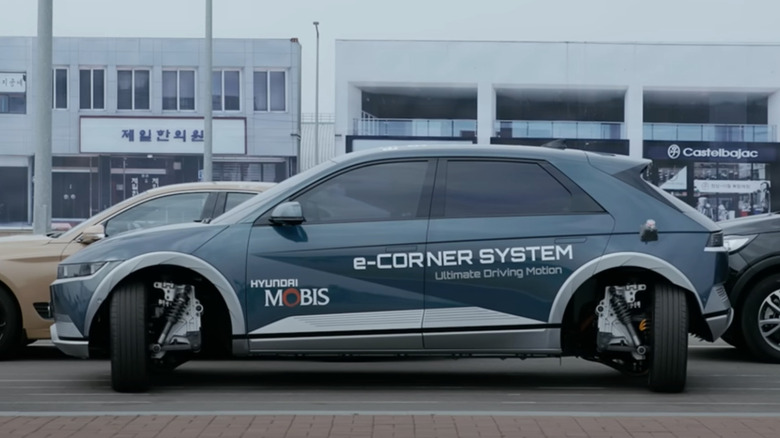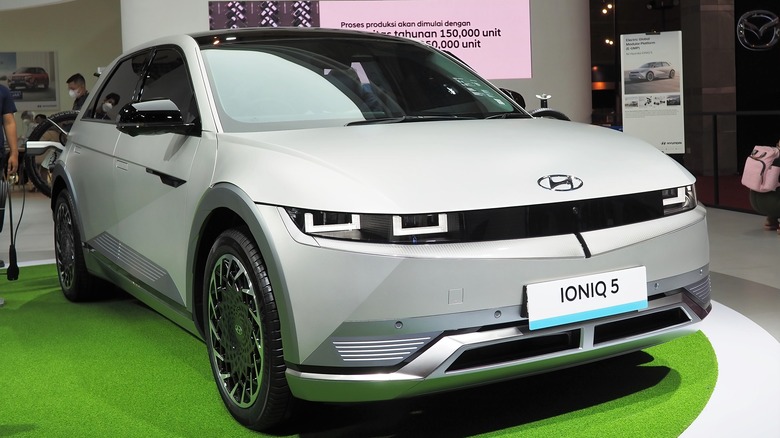What Is Four-Wheel-Steer And Why Does Your Car Need It?
Four-wheel steer, which is also known as all-wheel steer, rear-wheel steering, rear axle steering, or "crab walk" in some circles, is an incredibly useful feature that has cropped up on many cars but not quite caught on mainstream. Recently, Hyundai's Monis division revealed an Ioniq 5 that has been fitted with a very effective all-wheel steering system. You can also find a similar system fitted to the electric version of the Hummer. So we may be headed to a period where four-wheel steer has the potential to take off, again.
The system itself is nothing new, it was actually invented in the late 1800s and has shown up in many forms since then. The first production car in the U.S. to feature four turnable wheels was 1985's Honda Prelude — though some vehicles in the Asian market preceded that. However, like 3D movies, four-wheel steer seems to be one of those fads that crops up every few years before dying off again. Things may be different now, though. Here's a look at how it works, and why it never quite stuck before.
How does four-wheel steer work?
In a traditional car, the front wheels turn left or right and the car steers in that direction. With four-wheel steer, all four wheels are capable of turning. This effect can be achieved in a number of ways. Some older systems use a mechanical connection or hydraulic actuators to link the front and back wheels together. Then any movement in the front wheels is mirrored by those at the back. Modern implements use electrical systems to send signals to the back wheels and make them turn accordingly. As with many automotive features, each company (or auto group) has its own unique way of doing things, but if you truly enjoy staring at schematics, you can spend hours looking into the subtle differences between the Rolls Royce, BMW, Honda, GMC, Nissan, Porsche, and Ferrari's systems — to name a few.
In the simplest systems, the rear wheels would go in the opposite direction of the front wheels. More advanced systems build on the fact the rear wheels need to be dynamic for all-wheel steering to be as effective as possible. If the car is traveling at a high-speed, say over 35 mph, the rear wheels should point in the same direction as the front wheels. This makes things like lane changes quicker and more effective without damaging the tires or affecting stability. Both sets of wheels should point in the same direction if the steering angle is slight. At speeds lower than 35 mph, the system is more effective if the rear wheels point in the opposite direction to the front wheels.
What are the benefits of four-wheel steer?
There are numerous benefits to four-wheel steer, but to sum it up it drastically improves a vehicle's maneuverability. With some systems, cars can rotate on the spot or move laterally. This makes parallel parking an absolute breeze, and makes turning around at the end of a driveway a quick and simple maneuver. Even pulling into or out of a spot in a parking lot is easier with four-wheel steer. Vehicles can turn their back wheels and essentially pivot, so you can line right up with the spot you want to pull into. Cornering also gets tighter as the rear wheels can move in the opposite direction of the front wheels. All in all, four-wheel steer is great for navigating the narrow streets, difficult parking situations, and tight corners you'll find in many cities.
In addition to maneuverability, four-wheel steer can also make a vehicle more stable while traveling in a straight line and improves performance on a variety of terrains. So if you live in an area that has a particularly long and harsh winter, it could keep you safe once the roads start to ice over. Steering response is also quicker and requires less input, so things like lane changes are very safe and simple.
Why don't all cars have it?
Given its usefulness, what's holding it back? The first issue is, it's mechanically complex. Manufacturers don't typically go to the trouble of designing something difficult that customers aren't aware of and aren't demanding. The complexity also means there are more ways four-wheel steer can go wrong when compared to standard steering.
Most standard steering systems tend to be very reliable. A rack and pinion is basically just a bar that shifts left or right when the driver rotates the wheel. A tie rod attached to the end of the rack then turns the wheel. Four-wheel steering systems contain many mechanical and electrical parts. If any of them fail, the entire steering system can be impacted. All of this means the system is far more expensive to install, and far more expensive to repair than traditional steering systems. While it's a useful feature, many road users may prefer standard steering if it means the price of their new car won't increase by thousands of dollars.
Could EVs lead to four-wheel steer becoming more common?
The concept now seems to be cropping up again in a big way. Both GM and Hyundai are dabbling with the in it — with GM's version appearing on the electric Hummer and Hyundai's Mobis division displaying an Ioniq fitted with a superb-looking four-wheel steering system.
The Hyundai Ioniq 5 isn't a luxury car; it's very reasonably priced — especially for an EV. This may mean Mobis' "e-corner" system will soon be a fairly accessible optional extra. Some of the tech used in EVs, like advanced onboard computers, could make the system easier to implement. There's also an argument that the system is more beneficial in an EV than it is in a standard vehicle. EV batteries tend to add a lot of weight, and weight can drastically affect a car's handling. Four-wheel steer offsets this, and makes a vehicle handle far more precisely.
EVs are also a hotbed of "new" tech, and companies are keen on increasing uptake by tacking on features you won't really find on ICE cars. Four-wheel steer as standard could well become the next traction control, ABS system, or radar-guided cruise control. We might see it all the time in high-end cars, before it becomes standard in the mid-range in a few years, then shows up on almost everything in around a decade.



